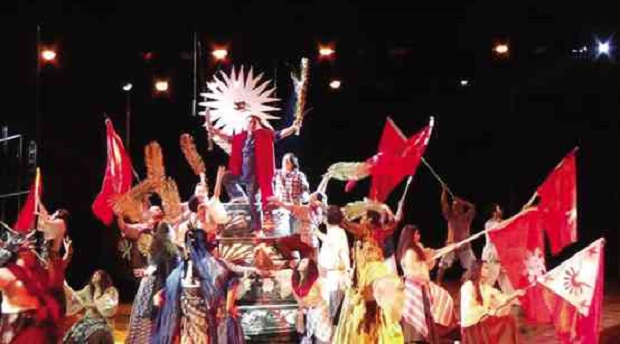
When the curtain opened in the first act of “San Andres B.,” one saw a highly cohesive and compact production design by Eric Cruz, with the orchestral ensemble not in the pit but in one visible part of the stage, becoming almost part of the action.
The luminous lighting design by Jay Aranda set the tone for the contemporary opera.
Watching Josefino “Chino” Toledo’s “San Andres B.” was quite an education. It required viewers to forget the conventional tunesmiths of opera and allow themselves a complete immersion in contemporary sound. Before this, the operatic treats at the Cultural Center of the Philippines had largely involved the warhorses: Verdi’s “La Traviata,” Puccini’s “Madama Butterfly” and Rossini’s “The Barber of Seville.”
Indigenous sound
Thus, once in a good while, we get an break from Western sounds to experience something uniquely Filipino.
In his composer’s notes, Toledo said “San Andres B.” blended the indigenous sound of kawayan (bamboo) instruments, the familiar Western orchestra and electronic and processed sounds.
A composite of all these sound sources was indeed what we got. The opera was unlike “Walang Sugat” or “Noli Me Tangere,” and more like distilled reverberations from Francisco Feliciano’s “La Lobra Negra,” especially in first-act numbers such as “Ang Pangitain” and “Magbayani Ay Di Biro,” on to “Reporma O Rebolusyon” and “Mga Anak Ng Bayan (Aling Pag-ibig Pa).”
The choral and orchestral ensembles, composed of the Auit Vocal Chamber Ensemble and Grupo 20-21, respectively, were the most outstanding elements of the production, showing how the marriage of indigenous and western sounds could prove magical.
Overstretched
The path-breaking sounds, however, found a rather uneasy pairing with the libretto by National Artist Virgilio Almario, which was full of symbolic musings that sounded overstretched in the first hour of the opera.
The role of Bonifacio was heroically sung by tenor Dondi Ong. But, while vocally agile and managing to do justice to the music, Ong sadly lagged behind in defining the emotional agitation and inner turmoil of his character.
Marvin Gayramon as Jose Rizal was also vocally engaging, but, like Ong, was unable to define his character acting-wise.
We found relief in the performance of soprano Margarita Roco as Gregoria de Jesus. Roco sang and acted the part with intensity and passion.
A far more solid sound, plus powerful acting, came from Antonio Rey Manuel Ferrer as Emilio Jacinto; indeed, he would have made a far more engrossing Bonifacio. The voice had power and character and was never quite forced. Ferrer’s speaking lines came out clear, and with this impression, one wished he had more scenes in the opera.
Insightful imagery
Given the complexity of the music and libretto, director Floy Quintos did one hell of a job with this new work. He made sure the staging didn’t overpower the music, and his collaboration with choreographer Krisbelle Paclibar-Mamangun produced insightful, thought-provoking imagery that made this contemporary opera quite a sight to see.
One has to commend Tanghalang Pilipino for putting up something as out-of-the-box as “San Andres B.” This is a country drowning in Verdi and Puccini arias, and the output of Toledo is a reminder that we have our own indigenous and orchestral sounds fit for operas revolving around national heroes.
The finale number, “Oras Na” might as well be an admonition that it’s about time we treat our contemporary composers with the same respect and enthusiasm we give the Western masters.

